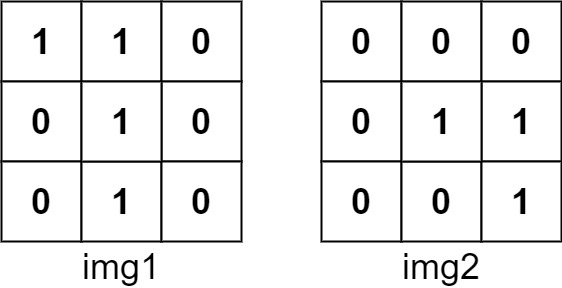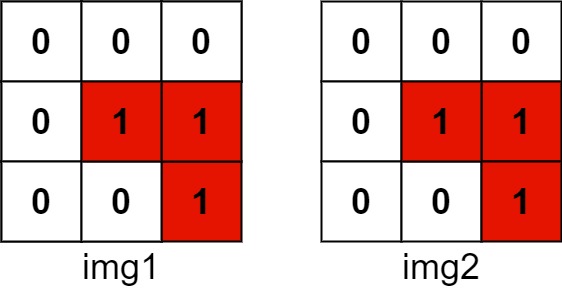Algorithm
Problem Name: 835. Image Overlap
You are given two images, img1 and img2, represented as binary, square matrices of size n x n. A binary matrix has only 0s and 1s as values.
We translate one image however we choose by sliding all the 1 bits left, right, up, and/or down any number of units. We then place it on top of the other image. We can then calculate the overlap by counting the number of positions that have a 1 in both images.
Note also that a translation does not include any kind of rotation. Any 1 bits that are translated outside of the matrix borders are erased.
Return the largest possible overlap.
Example 1:

Input: img1 = [[1,1,0],[0,1,0],[0,1,0]], img2 = [[0,0,0],[0,1,1],[0,0,1]] Output: 3 Explanation: We translate img1 to right by 1 unit and down by 1 unit.The number of positions that have a 1 in both images is 3 (shown in red).

Example 2:
Input: img1 = [[1]], img2 = [[1]] Output: 1
Example 3:
Input: img1 = [[0]], img2 = [[0]] Output: 0
Constraints:
n == img1.length == img1[i].lengthn == img2.length == img2[i].length1 <= n <= 30img1[i][j]is either0or1.img2[i][j]is either0or1.
Code Examples
#1 Code Example with Java Programming
Code -
Java Programming
class Solution {
public int largestOverlap(int[][] img1, int[][] img2) {
List, Integer> groupCount = new HashMap<>();
for (Pair c1 : nonZeroCoordinates1) {
for (Pair c2 : nonZeroCoordinates2) {
Pair vector = new Pair(
c2.getKey() - c1.getKey(), c2.getValue() - c1.getValue());
groupCount.put(vector, groupCount.getOrDefault(vector, 0) + 1);
maxOverlap = Math.max(maxOverlap, groupCount.get(vector));
}
}
return maxOverlap;
}
private List < Pair();
for (int i = 0; i < arr.length; i++) {
for (int j = 0; j < arr[0].length; j++) {
if (arr[i][j] == 1) {
coordinates.add(new Pair(i, j));
}
}
}
return coordinates;
}
}
Input
Output
#2 Code Example with Javascript Programming
Code -
Javascript Programming
const largestOverlap = function(A, B) {
const N = A.length
const count = constructMatrix(2*N, 2*N, 0)
for (let i = 0; i < N; i++) {
for (let j = 0; j < N; j++) {
if (A[i][j] === 1) {
for(let ii = 0; ii < N; ii++) {
for(let jj = 0; jj < N; jj++) {
if(B[ii][jj] === 1) {
count[i-ii+N][j-jj+N] += 1
}
}
}
}
}
}
let ans = 0
for(let row of count) {
for(let v of row) {
ans = Math.max(ans, v)
}
}
return ans
};
function constructMatrix(row, col, init = 0) {
const matrix = []
for(let i = 0; i < row; i++) {
matrix[i] = []
for(let j = 0; j < col; j++) {
matrix[i][j] = init
}
}
return matrix
}
console.log(largestOverlap([[1,1,0],
[0,1,0],
[0,1,0]],[[0,0,0],
[0,1,1],
[0,0,1]])>
Input
Output
#3 Code Example with Python Programming
Code -
Python Programming
class Solution:
def largestOverlap(self, A, B):
n, shift, rn = len(A), range(-1 * len(A) + 1, len(A)), range(len(A))
return max(sum(A[i][j] and B[i + v][j + h] for i in rn for j in rn if 0 <= i + v < n > j + h >= 0) for h in shift for v in shift)
Input
Output
#4 Code Example with C# Programming
Code -
C# Programming
using System;
namespace LeetCode
{
public class _0835_ImageOverlap
{
public int LargestOverlap(int[][] img1, int[][] img2)
{
int count = 0, N = img1.Length;
var counts = new int[N * 2, N * 2];
for (int i = 0; i < N; i++)
for (int j = 0; j < N; j++)
{
if (img1[i][j] == 0)
continue;
for (int m = 0; m < N; m++)
for (int n = 0; n < N; n++)
{
if (img2[m][n] == 0)
continue;
count = Math.Max(count, ++counts[N + i - m, N + j - n]);
}
}
return count;
}
}
}
Input
Output
